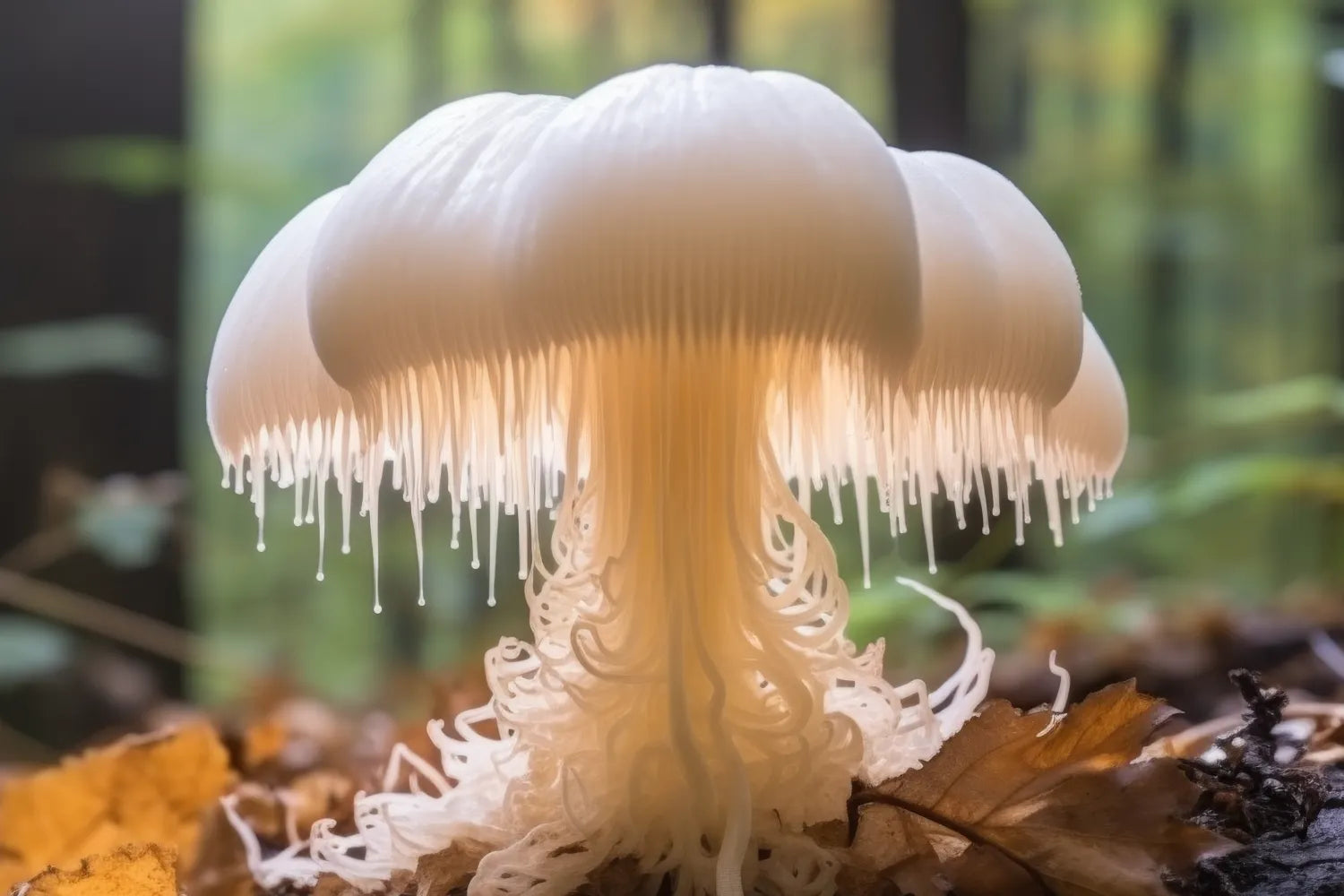Bear's Head Tooth Mushroom vs. Lion's Mane

Once you spend some time in the world of functional mushrooms, you’ll realize that there are some heavy-hitter mushrooms and some that tend to stay on the sidelines. You probably know about the star players like reishi, lion’s mane, chaga, and turkey tail — their benefits are the talk of the town.
But what about the side players like bear’s head tooth mushroom? This isn’t one you’ll see very often, and its benefits may seem mysterious. Plus, it’s very closely related to lion’s head mushroom, and the difference between the two can be hard to tell. In this article, we’re diving into these two cousins and their differences, including which one comes out on top.
What Is Lion’s Mane Mushroom?
Let’s start with the more well-known mushroom. Lion’s mane mushroom (Hericium erinaceus) is a white, fluffy-looking mushroom that’s named for its furry texture. This mushroom is pretty interesting because it doesn’t have a traditional mushroom shape.
Instead of a cap and stalk, this mushroom has a giant puffball shape. Another thing that makes lion’s mane stand out is that it grows pores along fuzzy tendrils instead of gills.
Lion’s mane grows in colder regions throughout North America, Europe, and Asia, and is popular among many different traditional forms of medicine for its benefits. It’s also completely edible, which makes it twice as useful!
What Is Bear’s Head Tooth Mushroom?
Bear’s head tooth mushroom (Hericium americanum) is in the same genus as lion’s mane mushroom, which makes them very closely related. Bear’s head tooth thrives under similar growing conditions as lion’s mane, although it can grow in slightly different areas. For instance, bear’s head tooth mushroom can be found in Vermont, while lion’s mane cannot.
Bear’s head tooth also grows pores along spines, although bear’s head tooth spines are much larger than lion’s mane spines. Bear’s head tooth also tends to grow in clusters, with multiple heads attaching to a visible stalk. Bear’s head tooth has very similar benefits to lion’s mane.
Differences Between Bear’s Head Tooth Mushroom and Lion’s Mane
After reading the descriptions of both of these mushrooms, you may be wondering what exactly makes them different. Although these mushrooms are closely related, it helps to think of them as siblings.
A set of siblings might look similar and have similar characteristics, but there are still some core differences that set them apart. Let’s take a closer look at these characteristics.
Appearance
One of the biggest differences between Americanus and Erinaceus is their appearances. Both are white and have long spines, which can lead to a shaggy appearance.
Lion’s mane typically features one main collection of spines that grow in a ball. It’s very uniform in shape and looks a lot like a lion’s mane.
However, bear’s head tooth features several “branches” of spines that cause it to look like many waterfalls overlapping each other. If you look closely, you may even be able to see the stalk of a bear’s head tooth mushroom without harvesting it, which is almost impossible with lion’s mane.
Potency and Taste
Both mushrooms aren’t just edible — they’re prized in the culinary world for their thick, meaty texture and nutty flavor. They taste remarkably like seafood and can even make a delicious vegan crab cake.
However, bear’s head tooth is said to be slightly less flavorful and a bit more stringy than lion’s mane. You likely wouldn’t notice the difference if you didn’t already know.
Growing Regions
Lion’s mane is very widespread, growing in multiple locations around the world. All it really asks for is a forest full of hardwood trees (especially birch) and some cool weather.
On the other hand, bear’s head tooth mushroom is mainly found in the Eastern United States and some parts of Canada. Bear’s head tooth also likes hardwood trees and actually grows on a wider range of trees than lion’s mane.
Availability
This is another huge difference between the two mushrooms. Lion’s mane is much more popular and that means it’s widely available. You can find lion’s mane extracts at almost any place that sells supplements (or you can check out our selection of lion’s mane mushroom coffee).
However, bear’s head tooth mushroom is much less popular in the wellness community and you might not find any supplements that feature it as an ingredient.
What Are the Benefits of Hericium Mushrooms?
Although Erinaceus and Americanum both have their differences, being part of the same genus means that their benefits are largely the same. These benefits include:
- Supporting Focus: Hericium mushrooms can help with focus and alertness, especially on days when it’s hard to pay attention.
- Supporting Gut Health: Hericium mushrooms also contain plenty of prebiotic fibers that can encourage a balanced gut microbiome.
- Encouraging Detoxification: These mushrooms can also support the body’s detox pathways, encouraging toxins and buildup to exit the body.
- Encouraging Feelings of Relaxation: Hericium mushrooms can help ease feelings of stress and anxiety, supporting overall mental health.
- Supporting Proper Sleep: Because these mushrooms can support mental health and gut health, they can also encourage restful sleep.
- Supporting Brain Health: Finally, Hericium mushrooms can support the brain’s production of nerve growth factor (NGF), supporting overall brain and nerve health.
It’s worth noting here that because lion’s mane is so popular, most of the research on Hericium mushroom benefits has specifically been conducted on Erinaceus fungi. Bear’s head tooth has been traditionally used the same way and may have similar benefits to lion’s mane, but it needs more research.
The Bottom Line
Bear’s head tooth mushroom and lion’s mane mushroom aren’t as different as you might think. In fact, these are two different species under the same genus. They taste pretty much the same and have similar benefits, so the main difference between these two mushrooms is popularity, availability, and appearance.
At Everyday Dose, we felt it was better to stick with what we know. With all the research surrounding lion’s mane mushroom, we felt more confident going with the popular option. To learn more about our ingredients and their benefits, visit the Everyday Dose blog today.
Sources:








